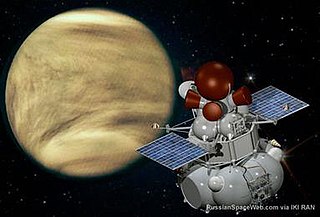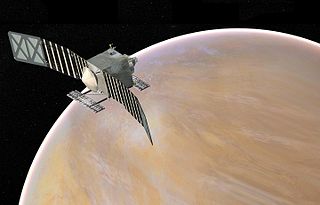
Mars Express is a space exploration mission being conducted by the European Space Agency (ESA). The Mars Express mission is exploring the planet Mars, and is the first planetary mission attempted by the agency. "Express" originally referred to the speed and efficiency with which the spacecraft was designed and built. However, "Express" also describes the spacecraft's relatively short interplanetary voyage, a result of being launched when the orbits of Earth and Mars brought them closer than they had been in about 60,000 years.

The Magellan spacecraft was a 1,035-kilogram (2,282 lb) robotic space probe launched by NASA on May 4, 1989. Its mission objectives were to map the surface of Venus by using synthetic-aperture radar and to measure the planetary gravitational field.

MESSENGER was a NASA robotic space probe that orbited the planet Mercury between 2011 and 2015, studying Mercury's chemical composition, geology, and magnetic field. The name is a backronym for Mercury Surface, Space Environment, Geochemistry, and Ranging, and a reference to the messenger god Mercury from Roman mythology.

The Discovery Program is a series of Solar System exploration missions funded by the U.S. National Aeronautics and Space Administration (NASA) through its Planetary Missions Program Office. The cost of each mission is capped at a lower level than missions from NASA's New Frontiers or Flagship Programs. As a result, Discovery missions tend to be more focused on a specific scientific goal rather than serving a general purpose.

Observations of the planet Venus include those in antiquity, telescopic observations, and from visiting spacecraft. Spacecraft have performed various flybys, orbits, and landings on Venus, including balloon probes that floated in the atmosphere of Venus. Study of the planet is aided by its relatively close proximity to the Earth, compared to other planets, but the surface of Venus is obscured by an atmosphere opaque to visible light.

Venera-D is a proposed Russian space mission to Venus that would include an orbiter and a lander to be launched in 2031. The orbiter's prime objective is to perform observations with the use of a radar. The lander, based on the Venera design, would be capable of operating for a long duration on the planet's surface. The "D" in Venera-D stands for "dolgozhivuschaya," which means "long lasting" in Russian.

The surface of Venus is dominated by volcanic features and has more volcanoes than any other planet in the Solar System. It has a surface that is 90% basalt, and about 65% of the planet consists of a mosaic of volcanic lava plains, indicating that volcanism played a major role in shaping its surface. There are more than 1,000 volcanic structures and possible periodic resurfacing of Venus by floods of lava. The planet may have had a major global resurfacing event about 500 million years ago, from what scientists can tell from the density of impact craters on the surface. Venus has an atmosphere rich in carbon dioxide, with a pressure that is 90 times that of Earth's atmosphere.
Io Volcano Observer (IVO) is a proposed low-cost mission to explore Jupiter's moon Io to understand tidal heating as a fundamental planetary process. The main science goals are to understand (A) how and where tidal heat is generated inside Io, (B) how tidal heat is transported to the surface, and (C) how Io is evolving. These results are expected to have direct implications for the thermal history of Europa and Ganymede as well as provide insights into other tidally heated worlds such as Titan and Enceladus. The IVO data may also improve our understanding of magma oceans and thus the early evolution of the Earth and Moon.

The Jupiter Icy Moons Explorer is an interplanetary spacecraft on its way to orbit and study three icy moons of Jupiter: Ganymede, Callisto, and Europa. These planetary-mass moons are planned to be studied because they are thought to have significant bodies of liquid water beneath their frozen surfaces, which would make them potentially habitable for extraterrestrial life.

VERITAS is an upcoming mission from NASA's Jet Propulsion Laboratory (JPL) to map the surface of the planet Venus in high resolution. The combination of topography, near-infrared spectroscopy, and radar image data will provide knowledge of Venus's tectonic and impact history, gravity, geochemistry, the timing and mechanisms of volcanic resurfacing, and the mantle processes responsible for them.

DAVINCI is a planned mission for an orbiter and atmospheric probe to the planet Venus. Together with the separate VERITAS mission, which will also study Venus, it was selected by NASA on June 2, 2021 to be part of their Discovery Program. Its acronym is inspired by Leonardo da Vinci in honor of his scientific innovations, aerial sketches and constructions.
The selection process for Mission 13 and 14 of the Discovery program began in February 2014, as NASA drafted an Announcement of Opportunity (AO) for the next Discovery mission. The winning mission proposals received $450 million in funding towards mission development and construction, along with bonus funding if missions were able to incorporate certain technologies. For Discovery Mission 13 and 14, NASA received 28 proposals, 16 of which notably centered around small Solar System bodies. Lucy, a multiple-flyby mission to the Jupiter trojans, and Psyche, a mission to the metallic asteroid 16 Psyche, were announced as the winners of the competition in January 2017, with launches in October 2021 and October 2023, respectively.

The mapping of Venus refers to the process and results of human description of the geological features of the planet Venus. It involves surface radar images of Venus, construction of geological maps, and the identification of stratigraphic units, volumes of rock with a similar age.
Venus Origins Explorer (VOX) is a concept orbiter mission to Venus.
Suzanne E. Smrekar is an American geophysicist and Deputy Principal Investigator for the Mars InSight lander and the principal investigator for the planned VERITAS space probe to Venus.

The International Mars Ice Mapper Mission (I-MIM) is a proposed Mars orbiter being developed by NASA, Japan Aerospace Exploration Agency (JAXA), the Canadian Space Agency (CSA), and the Italian Space Agency (ASI). As the mission concept evolves, there may be opportunities for other space agency and commercial partners to join the mission. The goal of the orbiter is the quantification of extent and volume of water ice in non-polar regions of Mars. The results are intended to support future Mars missions, especially with respect to the search for habitable environments and accessible In situ resource utilization (ISRU) resources. The International-Mars Ice Mapper is an "exploration precursor mission", comparing it to the Lunar Reconnaissance Orbiter (LRO) mission. The mission was envisioned to be launched as early as 2026. However, in March 2022, it was revealed in its fiscal year 2023 budget proposal that the US government would terminate NASA financial support for the Mars Ice Mapper, casting the project's future into uncertainty.

The Venus Emissivity Mapper (VEM) is a spectrometer for mapping the surface composition of Venus through a distinct number of atmospheric spectral windows. It will be one of the two payloads onboard the VERITAS mission, and will also be the VenSpec-M channel of the EnVision mission's spectrometer suite.

The Venus Orbiter Mission (VOM), unofficially known as Shukrayaan, is a planned Indian Space Research Organisation (ISRO) mission to study the surface and atmosphere of Venus.



















